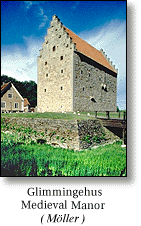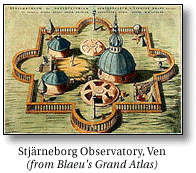|
There
are about 200 reasons why Skåne is called "Castle Country." Throughout
the green, mild countryside and the coastal reaches, the castles
are never far, and they cast a fairy tale glow across the land.
Many of these architectural treasures date back to the 14th and
15th centuries - one of the most opulent eras in Swedish history.
In their heydey, they were built to be impregnable, but today
some of them even offer hotel accommodations and restaurants.
But there is much more
to do in Skåne than tour its
castles. It would be hard to find a landscape better
designed for golf, and 30 of Sweden's best courses can be
found here. The region also has beaches on both the
Baltic and the North Sea, and its cuisine and history are
particularly distinct. For hundreds of years, it was a
kingdom in itself, and later it was ruled by Denmark.
This mixed heritage has made it rich in tradition.
Major Attractions:
 Malmö: Malmö:
Malmö's harbor is one of the most picturesque in
Scandinavia, and few leave the city without being
entranced by it and its other architectural masterpieces
- especially the 16th century town hall and city square.
Though Malmö is Sweden's third largest city, with
250,000 people it has the atmosphere of a town. It has a
major art scene, and part of the cityscape's charm are
the galleries and museums are woven into it.
Lund
Not far from Malmö is Lund, one of the most
important medieval centers in Scandinavia, and home to
the world-famous 300-year-old university. In 1990 Lund
celebrated its 1000th anniversary.
Helsingborg
Helsingborg is famous for its medieval keep, Kärnan, which looks out upon the Öresund strait. The
keep is 900 years old, and from its tower one can look
across the straight to Denmark and see Kroneborg Castle
Helsingør (Elsinore) - the home of Shakespeare's Prince
Hamlet.

Österlen
It is sometimes referred to as the Provence of
Sweden. Österlen lies in southeast Skane, and over the
centuries its classic landscape of rolling hills and
sandy beaches has appeared on countless artists'
canvases. The town of Ystad is still one of the
Sweden's major artist colonies, and its galleries are
ideal for collectors. One of Österlen's more captivating
sights are its famous Ale's Stones - a miniature
(but impressive), Stonehenge-like rock formation that was
once used to support the hulls of Viking ships under
construction. Here also is Glimmingehus, the most
well-preserved fortified medieval manor in Sweden.
Höganäs
This small town is best known as the source of
some of Sweden's finest traditional pottery, but there is
also a famous sculpture nearby, Nimis. Nimis is a seaside
tower that a local artist constructed from 250 tons of
driftwood and stone.
Båstad
Båstad and tennis are nearly synonymous in
Sweden. This town in northeastern Skåne is home to the
Swedish Open, and also to some of Scandinavia's finest
summer resorts. Kristianstad
The Renaissance church in Kristianstad, Trefaldighetskyrkan, is reputed to be the finest in all
of Scandinavia. The city is also the capital of the
Swedish film industry, and has an impressive film museum.
 Ven Ven
It was on this entrancing little island in the
middle of the Öresund--the strait between Sweden and
Denmark--that the famed Renaissance astronomer Tycho
Brahe built his remarkable observatory, Stjärneborg.
Among the most famous of Brahe's contemporary visitors
were King Christian IV of Denmark and King James VI of
Scotland. Today, visitors can pay a call to the recently
opened Tycho Brahe Museum to find out more about
Brahe's discoveries as well as his life on the island.
Copyright (c) 1997 -
2008 interKnowledge Corp.
All rights reserved. |

 Malmö:
Malmö:
 Ven
Ven